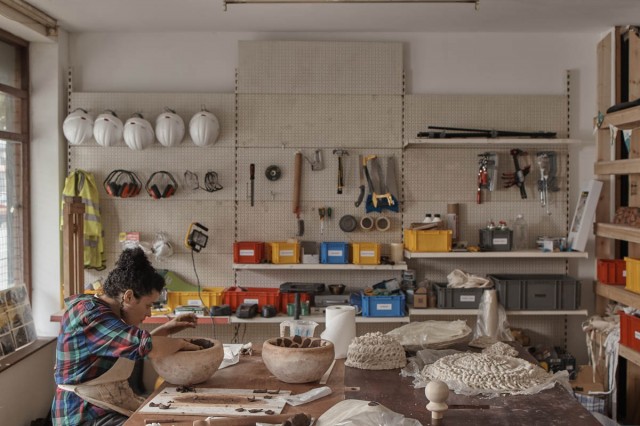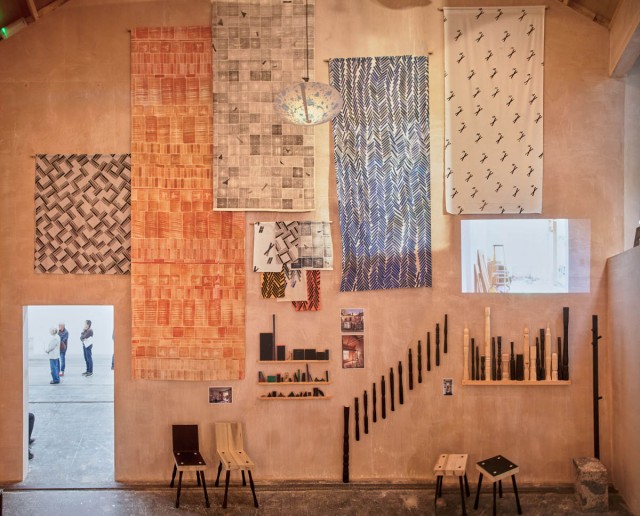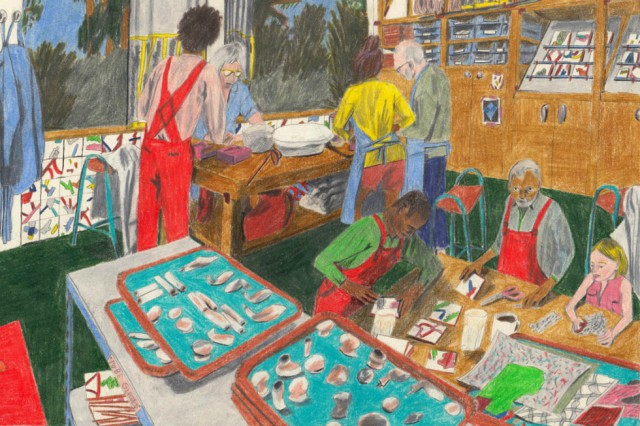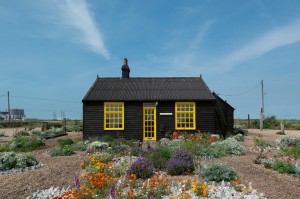Do It Yourself! The Big Interview: Assemble
Ahead of Monday’s Turner Prize winner announcement, Emma Sumner speaks to one of the nominees: an architectural collective who have been working very closely with Liverpool’s most determined community…
The first thing anyone visiting the Granby Triangle area in Toxteth, Liverpool, will notice is the energy. It’s pouring out of every doorway, window and kerbside garden of this once broken community. Devastated by top-down regeneration plans in the 1990s, and with their Victorian terraced houses earmarked for demolition, a core committee of residents refused to move and has been fighting to restore their homes, and the area, ever since.
Remaining residents have scrubbed walls, painted empty houses, encouraged street art, and organised monthly street parties, eventually forming the Granby Four Streets Community Land Trust (CLT) in 2011 — which focuses on Beaconsfield Street, Cairns Street, Jermyn Street and Ducie Street. They also started to work closely with London-based art, architecture and design collective Assemble on the vision for the area – which, as a direct result, has recently been nominated for one of the world’s most prestigious art awards: the Turner Prize.
I caught up with Assemble member Fran Edgerley in an unassuming terraced house on Cairns Street, a central hub where members of the collective camp out when staying in Liverpool, and where a local resident sometimes serves fry-ups to the local builders. It is fair to say that no one expected this DIY, social activism would one day win the approval of the Turner Prize committee.
The Double Negative: None of the Assemble collective are from Liverpool, so how did you end up getting involved in a regeneration project in Toxteth?
Fran Edgerly: About two years ago we were contacted by a social investment company called Steinbeck Studios, who had given some money to the Community Land Trust as a loan to help them secure some houses from the council for refurbishment, and they got in contact with us to come up with some speculative design proposals for one of the four streets.
We worked closely with the local residents and stakeholders to ensure that their ideas were included in the forward plans, putting together a document which had designs for the houses, but was also a convincing case to the council, as they have been fighting to protect these streets for nearly 30 years.

It was interesting, it was through us acting as designers in a more traditional sense — putting together a document with some nice Photoshop images — that led us to meeting the CLT in the first place, but that has since generated an incredibly rich and inspiring working relationship which now feels much more that we are acting as co-producers rather than client and service provider. It was a real meeting of minds.
In what way was it a meeting of minds? Can you explain a little more about your work with the CLT and their involvement with the Granby community?
The CLT and residents of Granby have had a really transformational impact on this area. Serious institutional neglect, as a result of numerous failed top-down planning initiatives, meant that people fighting to stay in the streets that had been saved from the waves of demolition were living in an incredibly bleak situation.
They started to take action through small acts of care by cleaning the streets, painting houses, planting and starting a street market, which all slowly accumulated and encouraged others to get involved. It made them visible and demonstrated a value of their streets and that area, and created a community of people living together in the street rather than isolated in their individual homes.
Assemble’s origins was in self-initiated design and build projects, working collectively to reimagine underused or overlooked spaces in the city. In different ways we had all been making the city malleable, taking action and advocating a kind of DIY spirit.

You’ve taken a lot of care over your plans for the regeneration of Granby’s community. Can you explain a little more about why your approach is quite different from any other regeneration project?
Our approach to the projects is always very broad; we like to make things or building things ourselves, to run events and generally be very hands-on. For Granby, this translated into making a series of different architectural elements and products for the homes, which reflected the level of personal care, ownership and creativity that the community had taken to their streets, and replicating this in the refurbishment of the houses so that the project wasn’t a typically generic regeneration.
You’ve been working with the Granby CLT for two years now; did you have any sort of inkling that you might be getting a nomination for the Turner Prize as a result?
None at all — the girl who took the call in the office thought it was for an obscure architecture Turner Prize that we had never heard of before. It was so outside of our conception of what could happen, and it continues to be a very strange and quite surreal experience. But it’s really exciting, the conversations we are being involved in as a result of the nomination are fascinating, and are helping us understand other activities similar to ours — like arte utile, which is a whole world that we were not that aware of.
Some of our past work has come from public art commissions, so some of us have been operating under the title of artist for a while, but it’s always felt more like us taking advantage of an opportunity to do a project that we want to. The autonomy you have when operating as an artist is very liberating, as you have an artistic freedom and licence that you don’t get when you’re acting as an architect in a more traditional relationship with a client.
The gallery format is very different to how you normally work; how did you decide what you were going to exhibit at Tramway, Glasgow, for the Turner Prize exhibition?
The same way we do with any project: by getting together as a group and having lots of ideas and conversations and drawing out those ideas and then having more discussions and then re-drawing the ideas. At first, we did think about how we might tell the story of what’s happened here, but that felt wrong, as our work has never been representational. It was difficult because we felt we were trying to engage people in a story which isn’t ours; we are new to the narrative and we don’t want people to think we are staking any kind of claim on the area and its history.

In the Turner Prize video [top], you mentioned that you were at first unsure if you should accept the nomination. What was it as a group that made you feel that it might be inappropriate to accept?
Different people in the group had different concerns; some felt it might categorise us in a certain way in which we hadn’t been before, others worried about how it might impact those living within Granby, others had a discomfort with the idea of being involved in the art world — as it isn’t a place that we’ve ever courted as a group and isn’t something that we’ve ever necessarily wanted to be that involved in.
When you did decide to accept the nomination, what did you expect to happen?
Well, the press attention was the main thing so we discussed at length how we could take advantage of this platform in an appropriate way without people peering through the community’s windows. The decision was made to set up the Granby Workshop, a new social enterprise manufacturing products for the home. Some of the products being made there were those originally designed for the houses, and others are new ones we’ve developed with the help of local artists and residents since.
The aim is to establish a sustainable organisation creating employment and a resource for creative activities in L8. All profits from sales will go to running a youth group to support that DIY attitude for the future generations.
Is the youth programme your way of maintaining a legacy of the work you’ve undertaken during your time here?
It’s a way for us to continue to encourage DIY, creativity, making and hands on activities within the area. A lot of people who are part of the CLT are a bit older, because they’ve been sticking it out for so long, so it feels important to work with a younger generation of community. The youth programme is still under development, but the idea is to involve young people in creative and practical activities, all the things we value in our practice, so they learn through making and feel empowered to take action and do things for themselves.
Emma Sumner
See Assemble at the Turner Prize 2015 Exhibition, at Tramway, Glasgow, until 17 January 2016 — FREE
The winner of the Turner Prize 2015 will be announced on Monday 7 December 2015 live on Channel 4, and presented by artist, writer and founding member of Sonic Youth Kim Gordon. The broadcast, which starts at 7.30pm, will be hosted by Lauren Laverne – more info on the history of the prize here
A range of homeware products are available from Granby Workshop now… Pre-orders placed before Christmas will receive a special gift!
The history, achievements and ongoing building and training projects of Granby and its CLT can be found on the granby4streetsclt.co.uk website





